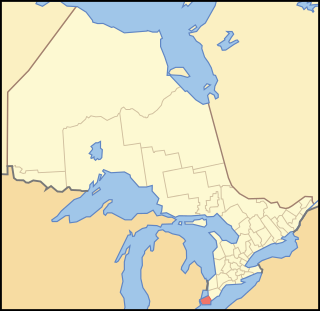
Essex County is a primarily rural county in Southwestern Ontario, Canada comprising seven municipalities: Amherstburg, Kingsville, Lakeshore, LaSalle, Leamington, Tecumseh and the administrative seat, Essex. Canada's southernmost county, Essex had a population of 181,530 as of the 2016 census.

Amherstburg is a town near the mouth of the Detroit River in Essex County, Ontario, Canada. In 1796, Fort Malden was established here, stimulating growth in the settlement. The fort has been designated as a National Historic Site.
The Battle of Windsor was a short-lived campaign in the eastern Michigan area of the United States and the Windsor area of Upper Canada. A group of men on both sides of the border, calling themselves "Patriots", formed small militias in 1837 with the intention of seizing the Southern Ontario peninsula between the Detroit and Niagara Rivers and extending American-style government to Canada. They based groups in Michigan at Fort Gratiot, Mount Clemens, Detroit, and Gibraltar. The Patriots were defeated by British and American government forces, respectively.

Duncan McArthur was a military officer and a Federalist and National Republican politician from Ohio. He served as the 11th governor of Ohio.

King's Highway 3, commonly referred to as Highway 3, is a provincially maintained highway in the Canadian province of Ontario which travels parallel to the northern shoreline of Lake Erie. It has three segments, the first of which travels from the Ambassador Bridge in Windsor to Highway 77 in Leamington. The second portion begins at Talbotville Royal outside of St. Thomas at Highway 4, and travels to the western city limits of Port Colborne. The road is regionally maintained within Port Colborne as Niagara Regional Road 3, but regains its provincial designation at Highway 140. Its third and final terminus is at Edgewood Park, within the Fort Erie town limits. From there, the road continues as Niagara Regional Road 3 to the Peace Bridge, where drivers can cross to the United States. The total length of Highway 3 is 258.2 km (160.4 mi), consisting of 49.2 km (30.6 mi) from Windsor to Leamington, 187.9 km (116.8 mi) from Talbotville Royal to Port Colborne and 21.1 km (13.1 mi) from Port Colborne to Edgewood Park.

Fort Amherstburg was built by the Royal Canadian Volunteers at the mouth of the Detroit River to replace Fort Detroit, which Britain was required to cede to the United States of America in 1796 as a result of the Jay Treaty.

The siege of Detroit, also known as the surrender of Detroit or the battle of Fort Detroit, was an early engagement in the British-U.S. War of 1812. A British force under Major General Isaac Brock with Native American allies under Shawnee leader Tecumseh used bluff and deception to intimidate U.S. Brigadier General William Hull into surrendering the fort and town of Detroit, Michigan, along with his dispirited army which actually outnumbered the victorious British and Indians.

Bois Blanc Island, commonly called Boblo Island, is an island in the Detroit River on the Canadian side of the border and is part of Amherstburg, Ontario. The island is about 4.0 kilometres (2.5 mi) long, 0.80 km (0.5 mi) wide and 110 hectares in size.
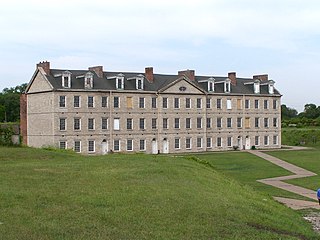
Fort Wayne is located in the city of Detroit, Michigan, at the foot of Livernois Avenue in the Delray neighborhood. The fort is situated on the Detroit River at a point where it is under half a mile to the Ontario shore. The original 1848 limestone barracks still stands, as does the 1845 fort. On the grounds but outside the original fort are additional barracks, officers quarters, hospital, shops, a recreation building, commissary, guard house, garage, and stables.

Essex Terminal Railway is a Canadian shortline terminal railroad, running from the City of Windsor, Ontario through LaSalle, to Amherstburg, Ontario, for a distance of approximately 21 miles (34 km). ETR has direct connections to Canadian Pacific Railway, Canadian National Railway and CSX. ETR is owned by Morterm Holdings. Founded in 1902, it is one of the oldest existing railways in Canada.

Fort Malden, formally known as Fort Amherstburg, is a defence fortification located in Amherstburg, Ontario. It was built in 1795 by Britain in order to ensure the security of British North America against any potential threat of American Invasion. Throughout its history, it is most known for its military application during the War of 1812 as Sir Isaac Brock and Tecumseh met here to plan the Siege of Detroit. It was the British stronghold during the War and is now one of the National Historic Sites of Canada. The Fort also had an important role in securing Upper Canada's border with Detroit during the Upper Canada Rebellion.
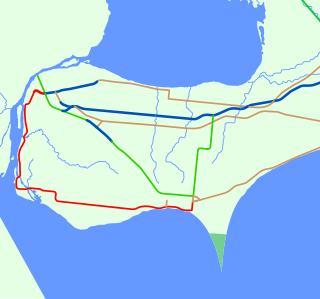
King's Highway 18, commonly referred to as Highway 18, was a provincially maintained highway in the Canadian province of Ontario, located entirely within Essex County. Since 1998, the majority of the former route has been known as Essex County Road 20. The route travelled at the southernmost point in Canada, along or near the shoreline of the Detroit River and Lake Erie between Windsor and Leamington, with Highway 3 as the terminus at both ends. The former route provides access to the communities of LaSalle, Amherstburg, Malden Centre, Harrow, Kingsville and Union.
Old Sandwich Town is located along the Canada–US border of the Detroit River, and was established in 1797. It is considered one of the oldest, most historically significant settlements in Ontario and has been the site of several historically significant events in Ontario's history. Many historic buildings remain in Old Sandwich Town and the area hosts an annual festival to celebrate its heritage. The area is now a neighbourhood of the city of Windsor.
The Amherstburg Echo was a newspaper which served Amherstburg, Ontario from 1874 to 2012.
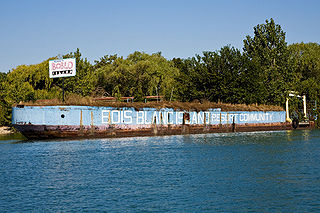
Boblo Island Amusement Park is an abandoned amusement park which operated from 1898 until its closure on September 30, 1993. Its amusement rides were sold in 1994.
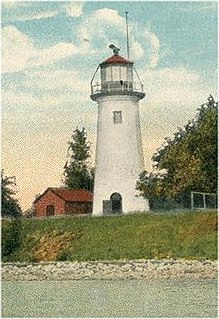
The Bois Blanc Island Lighthouse and Blockhouse is a National Historic Site of Canada located in Ontario on Bois Blanc Island, one of the islands in the Detroit River. It consists of a lighthouse, owned by Parks Canada, and a blockhouse, which is privately owned.
Knock Knock Ghost is a Canadian reality television series, which premiered on OutTV in 2015. Hosted by comedian Richard Ryder, the series features Ryder and actor Brie Doyle, as well as a psychic medium. The group travels to various locations across Canada which are purported to be haunted and conducts experiments to test whether it is possible to prove or disprove the existence of the afterlife.
John R. Park Homestead Conservation Area is the original home of John and Amelia (Gamble) Park. It is now an agricultural and living history museum of farm life in the 19th century in present-day Essex, Ontario.
Monette, also known as Manette, was a Native American enslaved woman of John Askin. She gave birth to three children who were educated and married into prominent families of the Great Lakes regions of present-day Michigan and Ontario, Canada. Her son was John Askin Jr. Daughter Catherine married Captain William Robertson, who operated one of Askin's boats, and was married a second time to Robert Hamilton, founder of Queenston, Ontario. Daughter Madeline was married to Dr. Robert Richardson, the surgeon of the Queen's Rangers stationed at Fort George.














